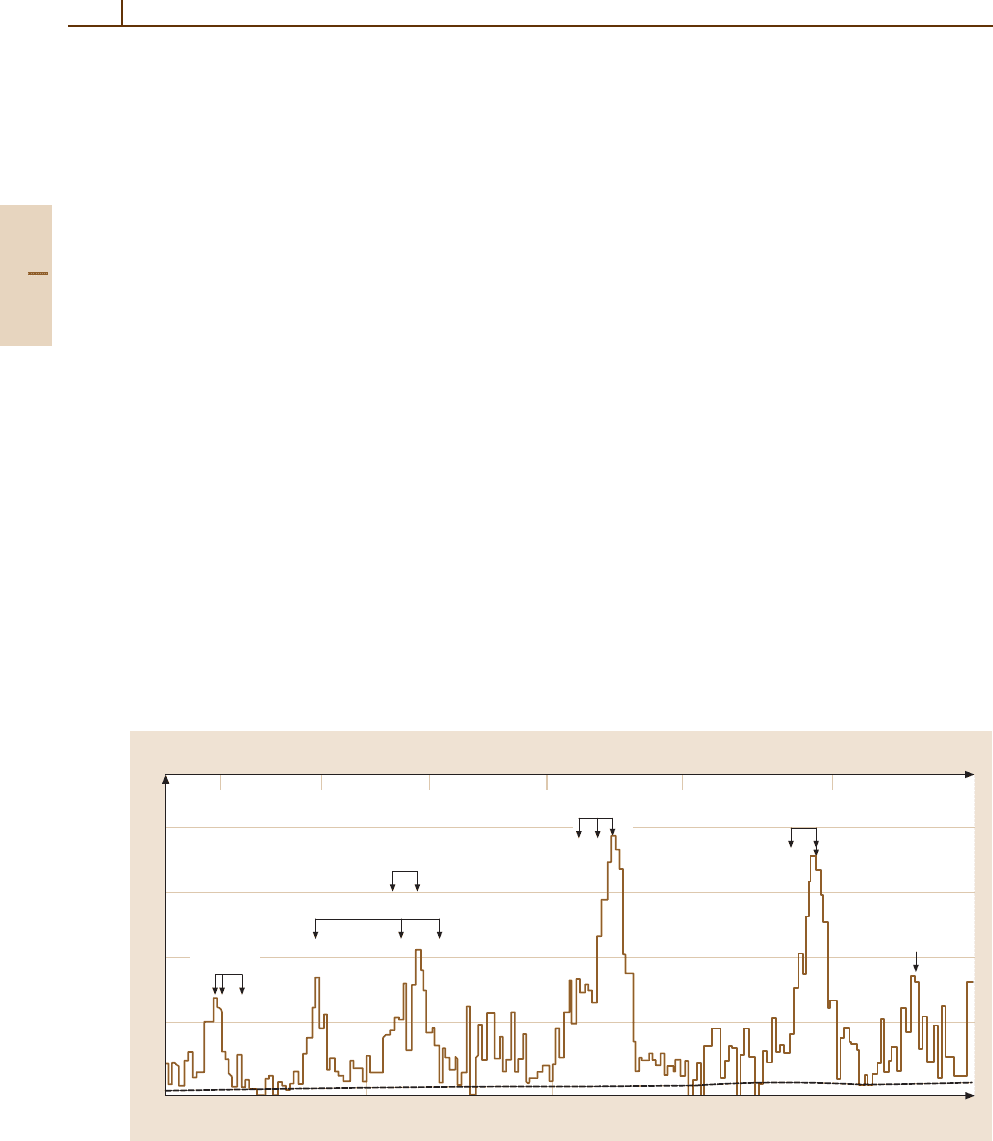Drake G.W.F. (editor) Handbook of Atomic, Molecular, and Optical Physics
Подождите немного. Документ загружается.


Quantum Information References 1231
81.161 J. K. Pachos, P. L. Knight: Phys. Rev. Lett. 91, 107902
(2003)
81.162 J. K. Pachos, E. Rico: Phys. Rev. A 70, 053620 (2004)
81.163 A. Kay, J. K. Pachos: New J. Phys. 6, 126 (2004)
81.164 M. P. A. Jones, C. J. Vale, D. Sahagun, B. V. Hall,
E. A. Hinds: Phys. Rev. Lett. 91, 080401 (2003)
81.165 D. M. Harber, J. M. McGuirk, J. M. Obrecht, E. A. Cor-
nell: J. Low Temp. Phys. 133, 229 (2003)
81.166 Y. J. Lin, I. Teper, C. Chin, V. Vuleti
´
c: Phys. Rev. Lett.
92, 050404 (2004)
81.167 C. Henkel, S. Pötting, M. Wilkens: Appl. Phys. B 69,
379 (1999)
81.168 P. K. Rekdal, S. Scheel, P. L. Knight, E. A. Hinds:
Phys. Rev. A 70, 013811 (2004)
81.169 S. Scheel, P.K. Rekdal, P.L. Knight, and E.A. Hinds:
quant-ph/0501149
81.170 A. Widera, O. Mandel, M. Greiner, S. Kreim,
T. W. Hänsch, I. Bloch: Phys. Rev. Lett. 92,160406
(2004)
81.171 B. Julsgaard, A. Kozhekin, E. S. Polzik: Nature (Lon-
don) 413, 400 (2001)
81.172 R. P. Feynman: Int. J. Theor. Phys. 21, 467 (1982)
81.173 S. Lloyd: Science 273, 1073 (1996)
81.174 H. Rabitz, R. deVivie–Riedle, M. Motzkus, K. Kompa:
Science 288, 824 (2000)
81.175 C. H. Bennett, J. I. Cirac, M. S. Leifer, D. W. Leung,
N. Linden, S. Popescu, G. Vidal: Phys. Rev. A 66,
012305 (2002)
81.176 M. B. Plenio, J. Eisert, M. Cramer: quant-
ph/0405142, Phys. Rev. Lett. (2005)
81.177 J. P. Dowling, G. J. Milburn: Philos. Trans. R. Soc.
London A 361, 1655 (2003)
Part F 81

1233
Application
Part G
Part G Applications
82 Applications of Atomic and Molecular
Physics to Astrophysics
Alexander Dalgarno, Cambridge, USA
Stephen Lepp, Las Vegas, USA
83 Comets
Paul D. Feldman, Baltimore, USA
84 Aeronomy
Jane L. Fox, Dayton, USA
85 Applications of Atomic and Molecular
Physics to Global Change
Kate P. Kirby, Cambridge, USA
Kelly Chance, Cambridge, USA
86 Atoms in Dense Plasmas
Jon C. Weisheit, Pullman, USA
Michael S. Murillo, Los Alamos, USA
87 Conduction of Electricity in Gases
Alan Garscadden, Wright Patterson Air Force
Base, USA
88 Applications to Combustion
David R. Crosley, Menlo Park, USA
89 Surface Physics
Erik T. Jensen, Prince George, Canada
90 Interface with Nuclear Physics
John D. Morgan III, Newark, USA
James S. Cohen, Los Alamos, USA
91 Charged-Particle–Matter Interactions
Hans Bichsel, Seattle, USA
92 Radiation Physics
Mitio Inokuti, Argonne, USA

1235
Applications o
82. Applications of Atomic and Molecular Physics
to Astrophysics
The range of physical conditions of density,
temperature, and radiation fields encountered in
astrophysical environments is extreme and can
rarely be reproduced in a laboratory setting. It is
not only reliable data on known processes that
are needed but also a deep understanding so that
the relevant processes can be identified and the
influence of the conditions in which they occur
fully taken into account.
We present here a summary of the processes
that take place in photoionized gas, collisionally
ionized gas, the diffuse interstellar medium,
molecular clouds, circumstellar shells, supernova
ejecta, shocked regions and the early Universe.
82.1 Photoionized Gas ................................1235
82.2 Collisionally Ionized Gas .......................1237
82.3 Diffuse Molecular Clouds ......................1238
82.4 Dark Molecular Clouds ..........................1239
82.5 Circumstellar Shells
and Stellar Atmospheres ......................1241
82.6 Supernova Ejecta .................................1242
82.7 Shocked Gas........................................1243
82.8 The Early Universe ...............................1244
82.9 Recent Developments...........................1244
82.10 Other Reading .....................................1245
References ..................................................1245
Almost all our information about the Universe reaches
us in the form of photons. Observational astronomy is
based on measurements of the distribution in frequency
and intensity of the photons that are emitted by as-
tronomical objects and detected by instrumentation on
ground-based and space-borne telescopes. Information
about the earliest stages in the evolution of the Uni-
verse before galaxies and stars had formed is carried
to us by blackbody background photons that attended
the beginning of the Universe. The photons that are the
signatures of astronomical phenomena are the result of
many processes of nuclear physics, plasma physics and
atomic, molecular and optical physics. The processes
that modify the photons on their journey from distant
origins through intergalactic and interstellar space to
the Earth belong mostly to the domain of atomic, mo-
lecular, and optical physics, as do the instruments that
detect and measure the arriving photons and their spec-
tral distribution. The spectra are used to classify galaxies
and stars and to identify the astronomical entities and
phenomena such as quasars, active galactic nuclei, grav-
itational lensing, jets and outflows, pulsars, supernovae,
novae, supernova remnants, nebulae, masers, protostars,
shocks, molecular clouds, circumstellar shells, accretion
disks and black holes.
Quantitative analyses of the spectra of astronom-
ical sources of photons and of the atomic, molecular,
and optical processes that populate the atomic and mo-
lecular energy levels and give rise to the observed
absorption and emission require accurate data on transi-
tion frequencies and wavelengths, oscillator strengths,
cross sections for electron impact, rate coefficients
for radiative, dielectronic and dissociative recombina-
tion, and cross sections for heavy particle collisions
involving charge transfer, excitation, ionization, dissoci-
ation, fine structure, and hyperfine structure transitions,
collision-induced absorption and line broadening. Data
on radiative association and ion–molecule and neutral
particle reaction rate coefficients are central to the in-
terpretation of measurements of chemical composition
in molecular clouds, circumstellar shells and supernova
ejecta.
82.1 Photoionized Gas
The Universe contains copious sources of energetic pho-
tons most often in the form of hot stars, and much of
the material of the Universe exists as photoionized gas.
Photoionized gas produces the visible emission from
emission nebulae, planetary nebulae, nova shells, star-
burst galaxies and probably active galactic nuclei [82.1].
Part G 82

1236 Part G Applications
Emission nebulae are extended regions of luminosity
in the sky. They arise from the absorption of stellar radi-
ation by the gas surrounding one or more hot stars.The
gas is ionized by the photons and excited and heated by
the electrons released in the photoionizing events. A suc-
cession of ionization zones is created in which highly
ionized regions give way to less ionized gas with in-
creasing distance from the central star as the photon flux
is diminished by geometrical dilution and by absorp-
tion. The outer edge of a nebula is a front of ionization
pushing out into the neutral interstellar gas. The dens-
ities are typically between 100 and 10 000 cm
−3
and the
temperatures between 5000 and 15 000 K. Nebulae are
also called Hii regions. At low densities, the luminosity
is low, but the ionized regions can still be detected by
radio observations.
Planetary nebulae are smaller in extent and more
dense. They have a passing similarity in appearance to
planets. Planetary nebulae are produced by the photoion-
ization of shells of gas that have been ejected from the
parent star as it evolved to its final white dwarf stage.
Because the core of the parent star is very hot the ir-
radiated gas is more highly ionized than are emisssion
nebulae and has a distinctive spectrum.
Photoionized gas is also found around novae. No-
vae are stars that have undergone spasmodic outbursts
and they are surrounded by faint shells of ejected
gas, photoionized and excited by the stellar radiation.
Some supernova remnants, which are what remains after
20
15
10
5
0
17 16 15 14 13 12
Energy (eV)
700 800 900 1000 1100
Counts / 320 s
Fe XVII
2p
6
–2p
5
3s
Fe XVII
2p
6
–2p
5
3d
VIIIO
Ly β Ly γ Ly δ
Ne IX
1s
2
–1s 2p, s
FI
R
Fe XVII
2p
6
–2p
5
4d
Ne X
Ly α
Ne IX
1s
2
–1s 3p
Wavelength (Å)
Fig. 82.1 X-ray spectrum of the supernova remnant Puppis A as observed by the Einstein satellite. Note the high level of
ionization with hydrogen-like ions of oxygen and neon, suggesting a high temperature. After [82.2]
a massive star has exploded, have spectra that also ap-
pear to be emanating from photoionized gas. The source
of ionization may be synchrotron radiation. Figure 82.1
shows the X-ray emission spectrum of a supernova
remnant.
The nuclei of starburst galaxies have spectra like
those of emission nebulae. They result from gas pho-
toionized by radiation from hot stars created in a period
of rapid star formation. Active galactic nuclei, such
as quasars, have a different spectrum characterized
by broad lines indicating a large range of velocities.
Photoionized gas is the most likely interpretation.The
ionizing source may be an accretion disk around a com-
pact object such as a black hole.
The ionization structure in a photoionized gas is
determined by a balance of photoionization
X
(m−1)+
+ hν → X
m+
+ e
−
(82.1)
and radiative
X
m+
+ e
−
→ X
(m−1)+
+ hν (82.2)
and dielectronic
X
m+
+ e
−
→
X
(m−1)+
∗
→ X
(m−1)+
+ hν (82.3)
recombination, and in plasmas with a significant popula-
tion of neutral hydrogen and helium, by charge transfer
recombination
X
m+
+ H → X
(m−1)+
+ H
+
(82.4)
X
m+
+ He → X
(m−1)+
+ He
+
. (82.5)
Part G 82.1

Applications of Atomic and Molecular Physics to Astrophysics 82.2 Collisionally Ionized Gas 1237
Many detailed calculations of the ionization structure of
photoionized regions have been carried out [82.1].
The ionizing source spectra of hot stars can
be obtained from calculations of stellar atmospheres
Sect. 82.5. Approximate values of cross sections for
photoionization for a wide range of atomic and ionic sys-
tems in many stages of ionization are available [82.3–6].
Calculations of higher precision and reliability that
incorporate the contributions from autoionizing reso-
nance structures exist for specific systems [82.7]. They
are undergoing continual improvements as increasingly
powerful computational techniques are brought to bear
on the calculations.
The cross sections for radiative recombination are
obtained by summing the cross sections for capture into
the ground and excited states of the recombining sys-
tem. Because of the contribution from highly excited
states which are nearly hydrogenic, the rate coefficients
are similar for different ions of the same excess nu-
clear charge. They vary slowly with temperature. In
contrast, dielectronic recombination is a specific process
whose efficiency depends on the energy level positions
of the resonant states. For nebular temperatures, the rate
coefficients vary exponentially with temperature. Ex-
plicit calculations have been carried out for many ionic
systems [82.8–10]. Because the photoionization cross
sections of the major cosmic gases hydrogen and helium
diminish rapidly at high frequencies, multiply charged
ions and neutral gas coexist in cosmic plasmas produced
by energetic photons and charge transfer recombina-
tion may control the ionization structure. For multiply
charged ions with excess charge greater than two, charge
transfer is rapid. For doubly charged and singly charged
ions, the cross sections are sensitive to the details of the
potential energy curves of the quasimolecule formed in
the approach of the ion and the neutral particle. Few re-
liable data exist. Some recent calculations may be found
in the papers [82.11–13].
Photoionized gas is heated by collisions of the en-
ergetic photoelectrons and cooled by electron impact
excitation of metastable levels, principally of O
+
and
O
++
,N
+
and N
++
,andS
+
and S
++
, followed by
emission of photons which escape from the nebula. Con-
siderable attention has been given to the determination
of the rate coefficients [82.14]. The resulting cooling
rates increase exponentially with temperature and keep
the temperature of the gas between narrow limits. Some
contribution to cooling occurs from recombination and
from free-free emission by electrons moving in the field
of the positive ions.
The luminosity of the photoionized gas comes from
the photons emitted in the cooling processes and from
radiative and dielectronic recombination. The radiative
recombination spectrum of hydrogen extends from the
Ly α line at 121.6 nm to radio lines at meter wavelengths.
The recombination spectrum can be predicted to
high accuracy, and calculations for a wide range of
temperature, density, and radiation environments have
been carried out for diagnostic purposes [82.15–18].
Electron impact and proton impact induced transitions
are important in determining the energy level popula-
tions and the resulting spectrum. Stimulated emission
often affects the intensities of the radio lines, espe-
cially those from extragalactic sources. Comparisons of
the predicted intensities in the visible and infrared with
theoretical predictions yield information on interstellar
extinction in the nebula and along the line of sight.
The relative intensities of the lines emitted by dif-
ferent metastable levels depend exponentially on the
temperature. The relative intensities of the lines at
500.7 nm and 436.3 nm originating in the
1
D
2
and
1
S
0
levels of O
++
vary as exp(33170/T ), and are commonly
used to derive the temperature T.
The electron density can be inferred from the lines
emitted from neighboring levels with different radiative
lifetimes for which there occurs a competition between
spontaneous emission and quenching by electron im-
pact. There are many possible combinations of lines.
The lines at 372.89 nm and 372.62 nm emitted by the
2
D
3/2
and
2
D
5/2
levels of N
+
are readily observable
and their relative intensity yields the electron density.
Radiative and dielectronic recombination lines are
often seen in the spectra, as are a few lines due to charge
transfer recombination. Fluorescence of starlight and
resonance fluorescence of lines emitted in the nebula
(called Bowen fluorescence by astronomers) also con-
tribute to the spectra of photoionized gases. Many data
are needed to adequately interpret the observations.
82.2 Collisionally Ionized Gas
Hot gas is found in the coronae of stars and particu-
larly the Sun, and in young supernova remnants, in
the hot phase of the interstellar medium, and in inter-
galactic space. In a hot gas the ionization is produced
by the impact ionization of the fast thermal electrons
and recombination is radiative and dielectronic [82.19].
Part G 82.2

1238 Part G Applications
The rate coefficients for electron impact ionization and
for recombination for any given ionization stage are
functions only of temperature, and hence so is the
resulting ionization distribution. When ionization and
recombination balance, coronal equilibrium is attained
in which the ionization structure is specified by the
temperature.
Recombination at high temperatures is dominated
by dielectronic recombination. At high temperatures,
dielectronic recombination is stabilized by transitions
in which the core electrons are the active electrons.
The associated emission lines lie close in frequency to
that of the resonant transition of the parent ion. They
are called satellite lines. Together with lines generated
by electron impact excitation, they provide a powerful
diagnostic probe of density and temperature. In many
circumstances such as in supernova remnants, coronal
equilibrium does not hold, and the ionization and re-
combination must be followed as functions of time. The
temperature also evolves as the hot plasma is cooled by
electron impact excitation and ionization.
The recombining gas produces X-rays and extreme
UV radiation which modify the ionization structure.
There is a particular need for more reliable data on
high energy photoionization cross sections, on collision
cross sections for electrons and positive ions, and on
21
22
23
4.0 5.0 6.0 7.0
–log P/n
e
n
H
(erg × cm
3
/s)
log T(K)
H
C
O
Fe
Ne
Mg
Si
Si
He
N
(OII)
Fig. 82.2 Total emissivity and emissivity by element as
a function of temperature in coronal equilibrium. The heavy
solid curve is total emissivity and the lighter lines are
contributions from individual elements. After [82.20]
the energy levels and transition probabilities of highly
stripped complex ions. Figure 82.2 shows the emissivity
of coronal gas.
82.3 Diffuse Molecular Clouds
Diffuse molecular clouds are intermediate between the
hot phase of the galaxy and the giant molecular clouds
where much of the gas resides. They are called diffuse
because they have optical depths of order unity, so pho-
tons can penetrate from outside the cloud and affect
the chemical composition. The atoms and molecules
are observed in absorption against background stars.
Translucent clouds with optical depths between about
2 and 5 are intermediate between diffuse and dark clouds
where photons from the outside still affect the chem-
istry. They can be observed both in absorption against
a background source or in emission in the radio.
The temperature is 100–200 K at the edges of
a diffuse cloud with a density of about 100 cm
−3
.In
a typical diffuse cloud the temperature decreases to
about 30 K at the center while the density increases to
about 300–800 cm
−3
. The chemistry is driven by ion-
ization from interstellar UV photons and from cosmic
rays.
Interstellar UV photons ionize species which have
ionization potentials less then that of atomic hydrogen.
Atomic hydrogen is so pervasive in the galaxy that UV
photons with energies higher than 13.6 eV are absorbed
near the source. The UV flux is a very important param-
eter in determining the composition of a diffuse cloud.
Photodissociation provides destruction which limits the
buildup of more complex species and so diffuse clouds
are dominated by simpler diatomic species.
Species with ionization potentials greater then hy-
drogen are mainly ionized by cosmic rays. Cosmic rays
are high energy nuclei which stream through the galaxy.
The cosmic ray ionization rate, the number of cosmic
ray ionizations per second per particle, is an important
parameter in interstellar chemistry. A lower limit to the
cosmic ray ionization rate may be set by measured high
energy cosmic rays reaching earth, giving an ionization
rate of ≈ 10
−17
s
−1
. More realistic estimates of the cos-
mic ray ionization rate from looking at recombination
lines suggest values of a few ×10
−17
s
−1
.
The hydroxyl radical OH is produced in a man-
ner similar to that discussed below in Sect. 82.5,and
removed by photodissociation. Thus in diffuse clouds,
Part G 82.3

Applications of Atomic and Molecular Physics to Astrophysics 82.4 Dark Molecular Clouds 1239
OH may be used to measure the cosmic ray ionization
rate, subject to uncertainties in the OH photodissociation
rate and the H
+
3
recombination rate. The OH abun-
dances give rates of several ×10
−17
s
−1
for many diffuse
clouds.
The carbon chemistry begins with the ionization of C
by UV photons:
C+ hν → C
+
+ e
−
. (82.6)
The carbon ion cannot react directly with H
2
by
C
+
+ H
2
→ CH
+
+ H , (82.7)
as this reaction is exothermic by 0.4 eV. Instead, the
chemistry proceeds by the slow radiative association
process
C
+
+ H
2
→ CH
+
2
+ hν. (82.8)
The CH
+
2
ion may either dissociatively recombine
CH
+
2
+ e
−
→ CH+ H , (82.9)
or react with molecular hydrogen
CH
+
2
+ H
2
→ CH
+
3
+ H . (82.10)
The CH
+
3
then undergoes dissociative recombination
CH
+
3
+ e → C+ H
2
+ H (82.11)
→ CH+ H + H (82.12)
→ CH
2
+ H (82.13)
→ CH+ H
2
, (82.14)
where the products are listed in order of decreasing
likelihood. The CH is removed by photodissociation
CH + hν → C+ H
(82.15)
and by photoionization
CH + hν → CH
+
+ e
−
. (82.16)
CH may also be removed by reactions with oxygen or
nitrogen atoms to form CO and CN respectively.
One of the outstanding problems in diffuse clouds
is to understand the large abundance of CH
+
relative to
CH. The problem is producing the CH
+
without pro-
ducing additional CH. Since most reaction paths go
through reaction (82.7), this is the most likely candi-
date. What is needed is some extra energy to overcome
the endothermicity. This energy must come from ei-
ther hot C
+
or from hot or vibrationally excited H
2
.
The most popular model is gas heated by a shock,
possibly a magnetic shock in which ions stream rela-
tive to the neutrals, giving a high effective energy.
Unfortunately, though these shock models can repro-
duce the CH
+
abundances, they also predict relative
velocities between the CH
+
and CH which are not
often observed. Recently there have been suggestions
that turbulence in the cloud could account for the CH
+
abundance.
The most comprehensive models of diffuse clouds
are by van Dishoeck and Black [82.21]. A collection
of photodissociation rates and photoionization rates is
given in Roberge et al. [82.22].
The UV flux is predominantly from stars and may be
as much as 10
5
times larger near an Hii region Sect. 82.1
than it is in the general interstellar medium. Regions
in which the chemistry is dominated by photons are
referred to as photon dominated regions or photodis-
sociation regions (PDR’s). In the presence of high UV
flux the cloud is much warmer than in a typical diffuse
cloud. Temperatures may reach 1000 K near the edge
of the cloud and 100 K far into the cloud. The chem-
istry differs from traditional diffuse cloud chemistry
in that the high temperatures allow endothermic reac-
tions to proceed. Sternberg and Dalgarno [82.23]have
published a comprehensive model of photodominated
regions.
82.4 Dark Molecular Clouds
Much of the mass of the galaxy is in the form of dark mo-
lecular clouds. The molecular clouds are sites of forming
new stars. They are composed primarily of hydrogen,
with about 10% helium and trace amounts of heavier
elements. They have densities of approximately 10
3
or
10
4
cm
−3
and temperatures between 10 and 20 K, and
often contain denser clumps. The clouds are optically
thick and so photons from the outside are absorbed on the
surface of the clouds. The interiors are heated and ion-
ized by cosmic rays which penetrate deep into the cloud.
The temperatures are too low to sustain much neutral
chemical activity in the clouds, and cosmic ray ion-
ization is important in driving the chemistry. In dense
clouds, the cosmic rays both initiate the chemistry and
limit it through the production of He
+
and through
cosmic ray induced photons.
Table 82.1 is a list of molecules that have been ob-
served in the interstellar medium, many of which have
also been found in other galaxies. It is likely that all
but H
2
are formed in the gas phase by ion–molecule re-
Part G 82.4

1240 Part G Applications
Table 82.1 Molecules observed in interstellar clouds
H
2
Hydrogen CH Methylidyne
CH
+
Methylidyne ion OH Hydroxyl
C
2
Carbon CN Cyanogen
CO Carbon monoxide CO
+
Carbon monoxide ion
NH Amidogen NO Nitric oxide
CS Carbon monosulphide SiO Silicon monoxide
SO Sulphur monoxide SO
+
Sulphur monoxide ion
NS Nitrogen sulphide SiS Silicon sulphide
PN Phosphorus nitride HCl Hydrogen chloride
SiN Silicon nitride NH
2
Amino radical
H
2
O Water C
2
H Ethynyl
HCN Hydrogen cyanide HNC Hydrogen isocyanide
HCO Formyl HCO
+
Formyl ion
N
2
H
+
Protonated nitrogen H
2
S Hydrogen sulphide
HNO Nitroxyl OCS Carbonyl sulphide
SO
2
Sulphur dioxide HCS
+
Thioformyl ion
C
2
O Carbon suboxide C
2
S Dicarbon sulphide
N
2
O Nitrous oxide H
2
CN Methylene amidogen
H
2
CO Formaldehyde H
2
CS Thioformaldehyde
NH
3
Ammonia HCNS Isothiocyanic acid
HNCO Isocyanic acid HOCO
+
Protonated carbon dioxide
C
3
H Propynylidyne C
3
N Cyanoethynyl
C
3
S Tricarbon sulphide C
3
O Tricarbon monoxide
C
2
H
2
Acetylene H
3
O
+
Hydronium ion
HCNH
+
Protonated hydrogen cyanide C
3
H
2
Cyclopropenylidene
CH
4
Methane H
2
CCC Propadienylidene
HCOOH Formic acid CH
2
CO Ketene
HC
3
N Cyanoacetylene HNCCC Cyanoacetylene isomer
HCCNC Ethynyl isocyanide C
4
H Butadinyl
NH
2
CH Cyanamide CH
2
CN Cyanomethyl radical
CH
2
NH Methanimine CH
3
CH Methyl cyanide
H
2
CCCC Butatrienylidene CH
3
SH Methyl mercaptan
C
5
H Pentynylidyne HCC
2
HO Propynal
CH
3
OH Methyl alcohol HC
3
NH
+
Protonated cyanoacetylene
NH
2
CHO Formamide CH
3
C
2
H Methyl acetylene
CH
2
CHCN Vinyl cyanide HC
5
N Cyanodiacetylene
C
6
H Hexatrinyl CH
3
NH
2
Methylamine
CH
3
CHO Acetaldehyde HCOOCH
3
Methyl formate
CH
3
C
3
N Methyl cyanoacetylene CH
3
C
4
H Methyl diacetylene
CH
3
2
O Dimethyl ether CH
3
CH
2
CN Ethyl cyanide
HC
7
N Cyanohexatriyne CH
3
CH
2
OH Ethyl alcohol
HC
9
N Cyano-octatetra-yne HC
1
1N Cyano-decapenta-yne
action sequences initiated by cosmic ray ionization. The
fact that isomers such as HCN and HNC are seen in
approximately equal abundances suggests a low dens-
ity gas phase environment. Reactions on surfaces and
the formation of grains are not well understood, but are
surely important.
The chemistry of molecular clouds is dominated by
ion–molecule reactions driven by cosmic ray ionization.
Part G 82.4

Applications of Atomic and Molecular Physics to Astrophysics 82.5 Circumstellar Shells and Stellar Atmospheres 1241
The cosmic rays primarily ionize H
2
:
H
2
→ H
+
2
+ e
−
, (82.17)
producing both H
+
2
and fast electrons. The fast electrons
produce additional ionizations. The H
+
2
quickly reacts
with H
2
to form H
+
3
H
+
2
+ H
2
→ H
+
3
+ H . (82.18)
The H
+
3
reacts with other species by proton transfer,
which then drives much of the interstellar chemistry.
As an example of the production of more complex
molecules in interstellar chemistry, we examine the re-
action networks leading to the production of water H
2
O
and the hydroxl radical OH. The H
+
3
ions formed by
cosmic ray ionization react with atomic oxygen to form
OH
+
O+ H
+
3
→ OH
+
+ H
2
, (82.19)
which quickly reacts with H
2
to form H
3
O
+
in an
abstraction sequence
OH
+
+ H
2
→ H
2
O
+
+ H , (82.20)
H
2
O
+
+ H
2
→ H
3
O
+
+ H . (82.21)
The H
3
O
+
then undergoes dissociative recombination
to form water and OH
H
3
O++e
−
→ H
2
O+ H , (82.22)
→ OH+ H
2
. (82.23)
The water is removed by reactions with neutral or
ionized carbon, which eventually lead to the produc-
tion of CO. OH is primarily removed by reactions with
atomic oxygen leading to O
2
.TheCOandO
2
are re-
moved by reactions with He
+
.TheHe
+
, generated by
cosmic ray ionization of helium, does not react with H
2
and so is available to remove species by reactions such
as
CO + He
+
→ C
+
+ O+ He . (82.24)
Water and OH are also removed by UV photons gen-
erated within the cloud. The clouds are too thick for
external UV photons to penetrate, but cosmic rays ex-
cite H
2
into electronically excited states which decay
through emission of UV photons. These internally gen-
erated photons play an important role in determining the
composition of the cloud. Gredelet al. [82.24]havecom-
piled a list of the photodissociation and photoionization
rates for cosmic ray induced photons.
Modern chemical networks for molecular clouds
include several hundred species and several thousand
reactions. A standard set of reaction rates is provided by
the UMIST (University of Manchester Institute of Sci-
ence and Technology) dataset [82.25, 26]. The dataset
may be obtained from the UMIST Astrophysics Group
homepage (http://saturn.ma.umist.ac.uk:8000/).
The clouds also contain dust particles as evidenced
by the extinction curves for clouds and the observed de-
pletions of heavier elements. The importance of surface
chemistry on these dust particles to interstellar clouds
is still uncertain. Dust particles are the best candidate
to be the site of formation of molecular hydrogen, be-
cause known gas phase reactions fail to produce H
2
in
the quantities observed.
82.5 Circumstellar Shells and Stellar Atmospheres
The continuum emission from a star is very nearly that
of a blackbody. This emission is then absorbed and re-
distributed by the atmosphere of the star. The spectrum
of the star is thus determined by its atmosphere. In the
hottest stars, most of the material is ionized and the ab-
sorption lines are predominantly those of ions, while in
the coldest stars, molecular lines are prominent. Kurucz
has calculated models with continuum spectra and the
inclusion of a large number of absorption lines [82.27].
There are two major projects for calculating the required
atomic data. In 1984 an international collaboration
named the Opacity Project was set up to calcu-
late accurate atomic data needed for opacity calcula-
tions [82.28,29]. The other earlier project is called
OPAL. The two sources of data are compared
in [82.30,31].
Low and intermediate mass stars eject circumstellar
envelopes in their red giant phase near the end of their
evolution. Circumstellar envelopes are an important part
of astronomy and they are a likely location for dust
formation. They provide an interesting environment for
studying molecules because they represent a transition
between very high density stellar atmosphere environ-
ments to low density interstellar environments. These
objects evolve to become planetary nebulae Sect. 82.1.
We are fortunate in having one example, IRC 10216,
which is very close to the Sun. The brightest 10 µm
source beyond the solar system, IRC 10216 is a carbon-
Part G 82.5

1242 Part G Applications
rich star surrounded by dust and gas it ejected in a strong
stellar wind. The central star is so shielded that it is
almost undetectable at optical wavelengths, and was not
discovered until the 2 µm survey. IRC 10216 is where
most of the circumstellar molecules are detected, and
has greatly increased our understanding of circumstellar
envelopes.
The envelopes are ejected by the red giant in its
final phase of evolution. The mass loss rates increase
to ∼ 10
−4
solar masses per year and temperatures in
the envelope are of order 1000 K. Close to the star, the
density is high and the chemistry is characteristic of
thermal equilibrium. The situation is quite unlike any
interstellar environments. For example in IRC 10216,
the HNC is over one hundred times less abundant than
HCN, whereas in molecular clouds, they have about the
same abundance.
If the star is oxygen-rich, large amounts of H
2
Oare
formed and if it is carbon-rich, C
2
H
2
.Thishightem-
perature environment forms both molecules and grains.
The high obscuration of the central source indicates that
grains are formed in these envelopes. Polycyclic aro-
matic hydrocarbons (PAH’s) or some similar species are
observed in carbon rich planetary nebulae. These large
molecules must have been produced when the object
was a carbon rich circumstellar envelope.
As the material flows out from the star the den-
sity and temperature decrease. As the density becomes
lower, three body reactions become less important and at
some point the products of these reactions are frozen out
in a similar manner to the evolution of molecules in the
early universe (Sect. 82.10). In the outermost portions of
the circumstellar envelope, molecules are dissociated by
interstellar UV photons. The penetrating UV radiation
is shielded by dust, H
2
, and CO. The relative abun-
dances can vary rapidly with radius, and observations
provide abundance and radial distribution, a wealth of
data for modelers. Circumstellar chemistry is reviewed
by Omont [82.32] and recent chemical models are given
in [82.33–35].
82.6 Supernova Ejecta
A supernova, the explosion of a massive star following
core collapse, is one of the most spectacular displays in
the Universe. The explosion occurs when the iron core
of a massive star collapses to form a neutron star and the
rebound shock and neutrino flux eject the outer portion
of the star. The ejected portions of the star are rich in
heavy elements produced in the interior of the progenitor
star.
We are fortunate to have had in our lifetime a super-
nova which was close and in an unobscured line of
sight. Supernova 1987A, the first supernova observed in
1987, went off in the Large Magellanic Cloud, a small
satellite galaxy to our own. It was the first supernova
visible to the naked eye in nearly 400 years (since
the Kepler supernova in 1604). Using the full range of
modern astronomical instruments has allowed us to get
detailed spectra of the evolving ejecta which has greatly
increased our knowledge of supernovae. We will use
SN1987A as an example of supernova ejecta.
Initially the temperature of the ejecta of SN1987A
was high, ≈ 10
6
K, but it quickly cooled through adi-
abatic expansion and radiation from the photosphere.
The temperature leveled off at several thousand degrees
because of heating by radioactive nuclei, first
56
Ni and
then
56
Co, formed in the explosion. The dynamics is
homologous free expansion: the velocity scales linearly
with the radius r(t) = vt where v the velocity and t the
time since the explosion.
The ejecta at first were optically thick and the
spectrum resembled that of a hot star continuum with
absorption lines from the surface. After a few days, the
temperature dropped, but the ejecta remained optically
thick and continued to show strong continuum emission.
As the ejecta expand, the temperature drops, the ejecta
become optically thin, and the spectrum is dominated by
strong emission lines, superficially resembling an emis-
sion nebula Sect. 82.2. The emission is dominated by
neutral atoms and singly ionized species.
The gas is heated and ionized by the gamma rays
from radioactive decay. The gamma rays Compton scat-
ter, producing X-rays and fast electrons. The X-rays
further ionize the gas and produce multiply charged ions
through the Auger process. These multiply charged ions
recombine through charge transfer with neutral atoms.
Further charge transfer determines the relativeionization
of different species, with the lowest ionization poten-
tial species more ionized than the higher ionization
potential species. The development of the infrared and
optical spectrum of Supernova 1987A has been recently
reviewed by McCray [82.36].
One of the great surprises in the spectrum of Super-
nova 1987A was the discovery of molecules in the
Part G 82.6
